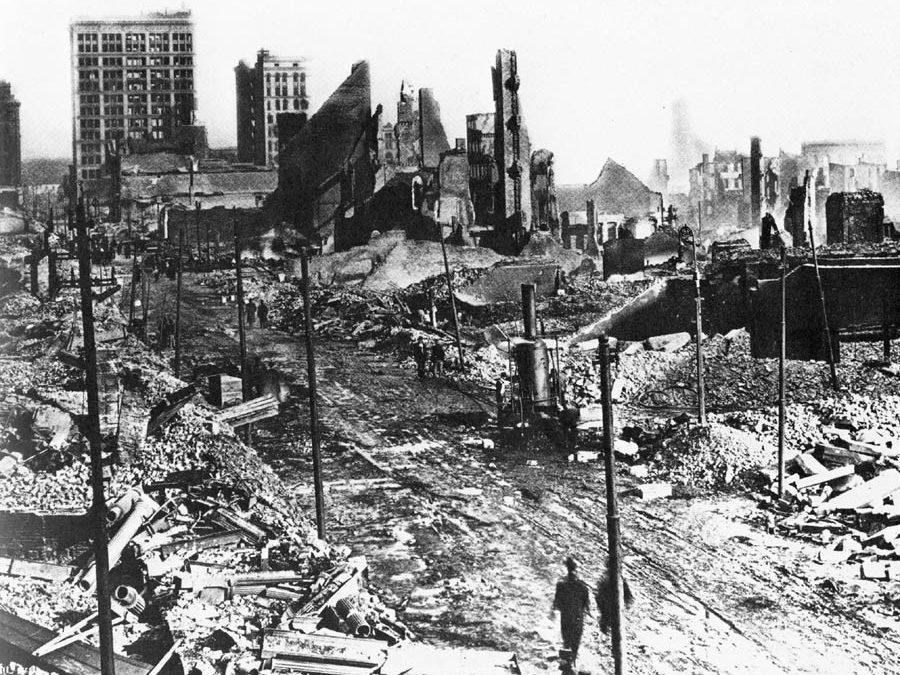Even quick fires can change cities forever. London, Chicago and San Francisco all burned to their foundations, only to have more modern versions rise from the ashes. Baltimore underwent its own less-famous fire over a century ago, a 30-hour inferno that burned over 70 blocks of downtown. And while the marks of devastation aren’t immediately apparent today —the tall buildings and dense infrastructure all testify to how a city can spring back from even the worst disaster — there is one big relic of that terrifying winter day in February 1904, right under your feet: Wider streets.
Heading into downtown, two lanes abruptly widen into five, causing occasional confusion. Most people dismiss this as a quirk of urban engineering, not realizing that people had fought for their lives on that very spot.
The Baltimore Fire directly resulted in only one death, which may be one of the reasons it’s been forgotten while blazes like Chicago’s stay prominent in the collective memory. Nonetheless, the damage was enormous: in 30 hours, over 1,526 buildings were consumed. High-rise offices burned down to their steel frames; the piers of the Inner Harbor, one of the city’s most vital connections to the world, went up in flames. At the fire’s epicenter, temperatures hit 2,500 degrees Fahrenheit.
Yet the city survived — partly through chance, and also through the efforts of people in Baltimore and along the whole East Coast.
Destruction
At 10:48 on the morning of February 7, 1904, the firefighters of Engine Co. 15 responded to an automatic alarm at John Hurst & Company, at Liberty Street on the south side of what is now Redwood Street, west of City Hall. They arrived to find the building filled with smoke; a little later, an explosion blew the roof off, showering the nearby streets with burning embers.
“The Hurst building was fairly new. The owners had built under the sidewalk, in order to have use of that extra space, in this case for shipping and wrapping,” Peter Petersen, a Johns Hopkins University professor whose book, The Great Baltimore Fire, detailed both the blaze and its aftermath, told me in an interview in 2007. “For additional illumination, they had glass holes in the sidewalk. One or more got punched out, and it’s assumed that a cinder from a cigar or cigarette butt fell into the hole.” That, at least, was the cause later determined by an insurance underwriter’s committee.
Within minutes of the Hurst building explosion, other buildings caught on fire. An hour after the initial alarm, over two-dozen vehicles had arrived to fight the growing inferno, and Fire Chief George W. Horton had requested the first out-of-state help, from Washington, DC.
Fueled by heavy winds from the southwest, the fire ate its way east, threatening the very heart of the city. When Washington’s much-needed fire engines arrived — to the cheers of the populace — they met a very unpleasant surprise: their hose couplings were incompatible with Baltimore fire hydrants. Binding the connections with canvas did little good. By Sunday night the first fire companies had arrived from Wilmington, Delaware and Philadelphia, only to confront the same problem.
Nor was that the only issue. A falling electric wire hit Chief Horton within an hour of his arrival on the scene, and the opiates administered in the course of medical treatment knocked him out of commission for the duration. “[Horton] had credibility and maturity and experience,” Petersen said. Unfortunately, his replacement, Fire Department District Engineer August Emrich, did not.
As the fire spread, calls for a firebreak went up. Had Horton been in command, he probably would have vetoed the idea. The dynamite, delivered from quarries and set by quarrymen, blew out windows and scattered debris instead of causing implosions, helping the blaze spread further.
By midday Monday, some 19 fire departments from along the East Coast were on the scene, the largest men-and-equipment contingent from New York City. Flames had consumed the city’s financial district, including the Chamber of Commerce building and the Stock Exchange, and moved south to consume the Inner Harbor. But the flames stopped at Jones Falls, finally brought under control by the firefighter crews. “Jones Falls was a wastewater canal and a stink-hole; but had it not been there, the fire would have gone to the east,” Petersen said.
Aftermath
Despite the ruin, the fire caused only a few casualties. An unnamed African-American man, burned beyond recognition, was pulled from the waters of the Inner Harbor; he had been trapped on the pier as it burned. Two National Guard members and two firefighters also died in the days after the fire from pneumonia, which they may have caught while fighting the blaze. The stress of the fire’s aftermath may have contributed to Mayor Robert McLane’s suicide on May 30.
The economic costs were high. Around 15 percent of Baltimore’s 539,000 residents were left unemployed by the disaster, while some 2,500 businesses were destroyed.
“It is a cruel blow to the material interests of Baltimore, but not a crushing one,” read an op-ed in The Sun, whose ink-stained wretches had abandoned their building and fled to Washington, DC, where they printed the next edition using the presses of The Washington Star. “For the business men of this city, with undaunted spirit, will surely prove themselves equal to the occasion, stupendous as the disaster is, and long as its effects will be felt.”
Indeed, the city sprung back. Money previously earmarked for wide boulevards and green spaces went to repairing public places. There was a drive for the standardization of fire hydrant couplings, and new building codes for skylights and windows; the use of chicken wire on the inside of window-glass, particularly in schools, accelerated — the idea being that, if there were ever another fire, the windows would be prevented from blowing out as easily.
Fire had consumed most of Baltimore. But instead of destroying it, a modern city rose in its place.

